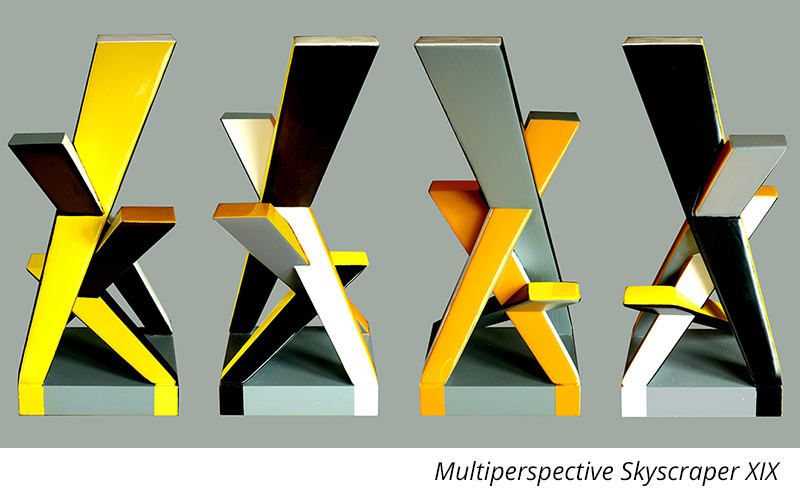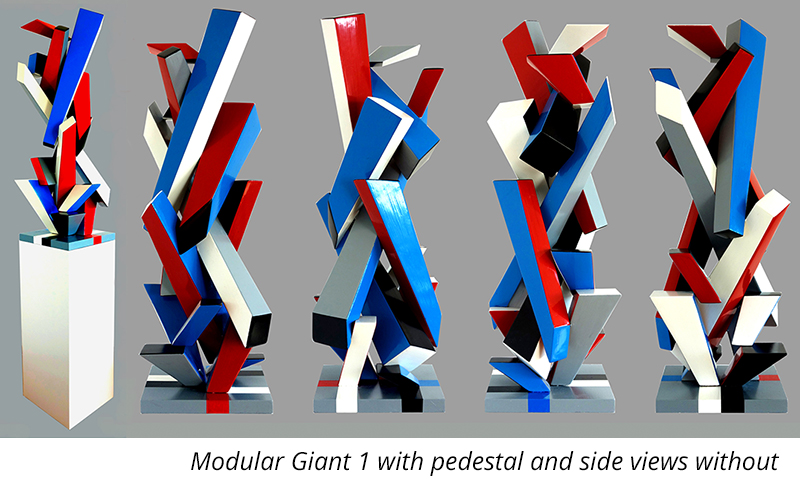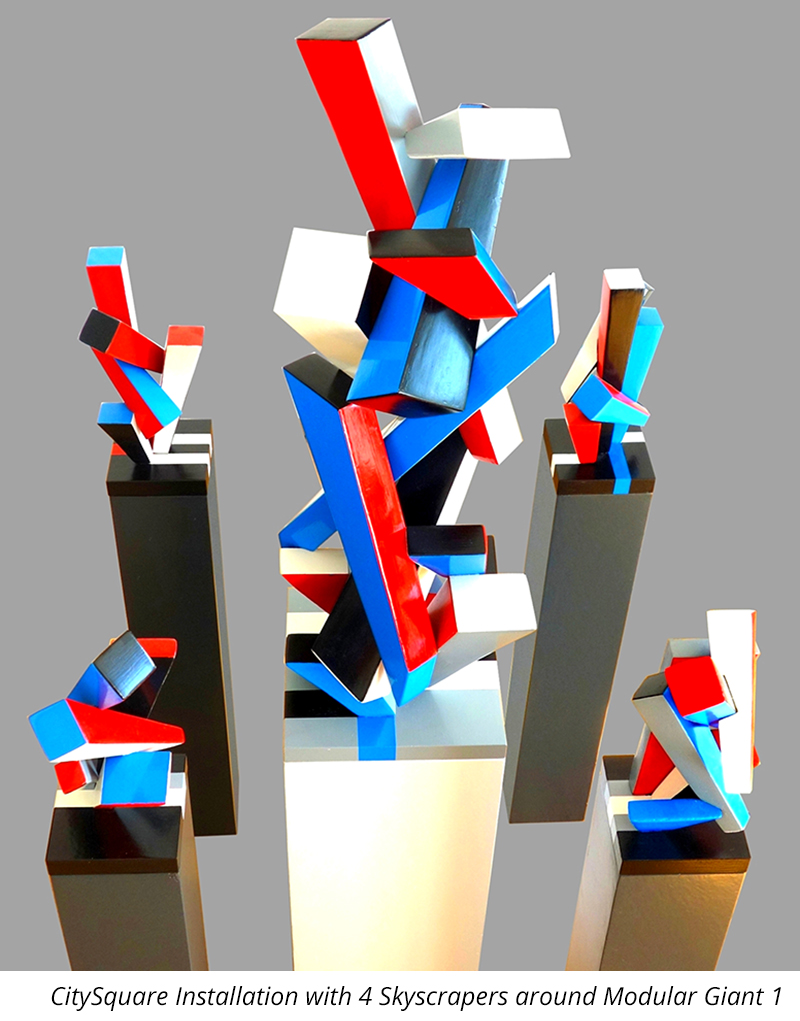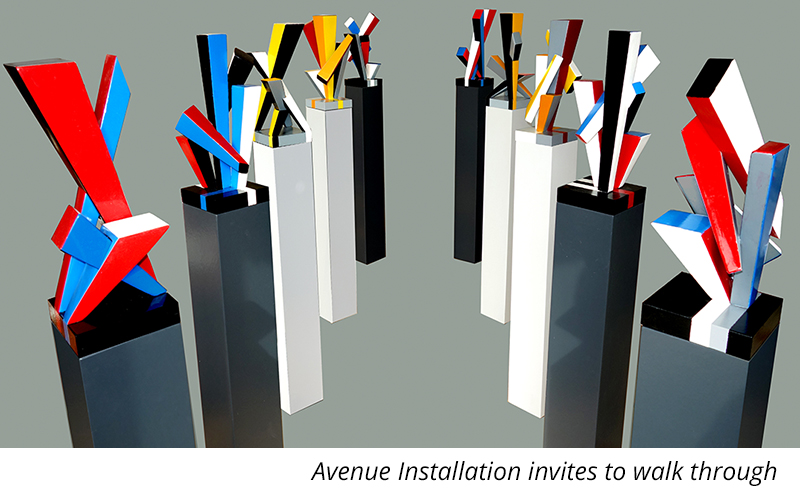
Your work “Skyscraper VII”-Multiperspective Side Views” was recognized as the winner of the Abstract by UPWARD gallery competition. Please tell us more about the “Skyscrapers” series.
I explore architecture from different viewpoints, from provocation, like in my wall sculpture series “Architecture Criticism” up to beautification, like in my here reported sculpture series “Skyscrapers” and in my installation series “Vertical Constructivist Urbanism”.
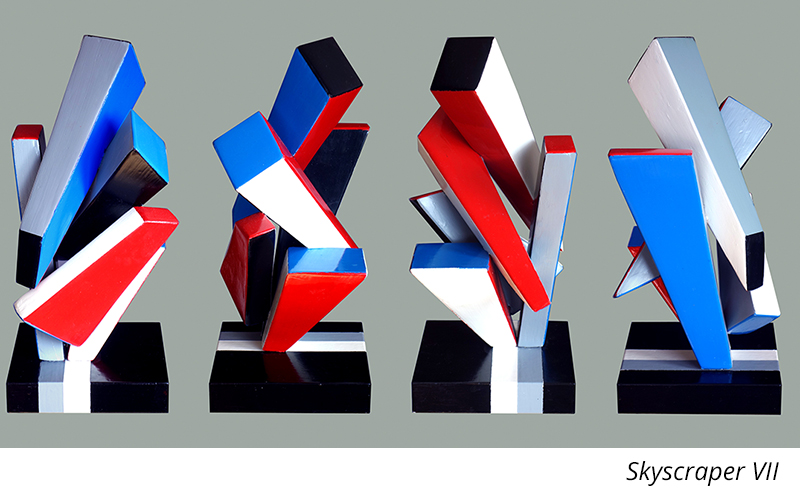
“Sprouting” is the natural process by which simple grains grow to complex plants
I have pursued this concept since 2011 intermittently until today. As years went by,the sculptural complexity has steadily been increased, from three up to six different 3D-shapes. I strictly use constructivist features with rigid geometric, asymmetrically arranged modules which cross, intersect or interpenetrate. Together with a minimalist primary color scheme, either blue-red, yellow-red, or only yellow contrasted with black, white and gray, innovative un- orthodox aesthetic skyscraper models have been created. In addition, these are multi-perspective, no side looks like the other.
The awarded “Skyscraper VII” is one of fourteen similar artworks with the same external dimensions. The inner structure of a sculpture appears seemingly chaotic, nevertheless revealing a certain order and exceptional aesthetics and beauty.
My most recent ”Skyscraper Giant 1“ is significantly taller and due to 13 inside modules he is characterized by a striking structural diversity and multiperspectivity in outside views.
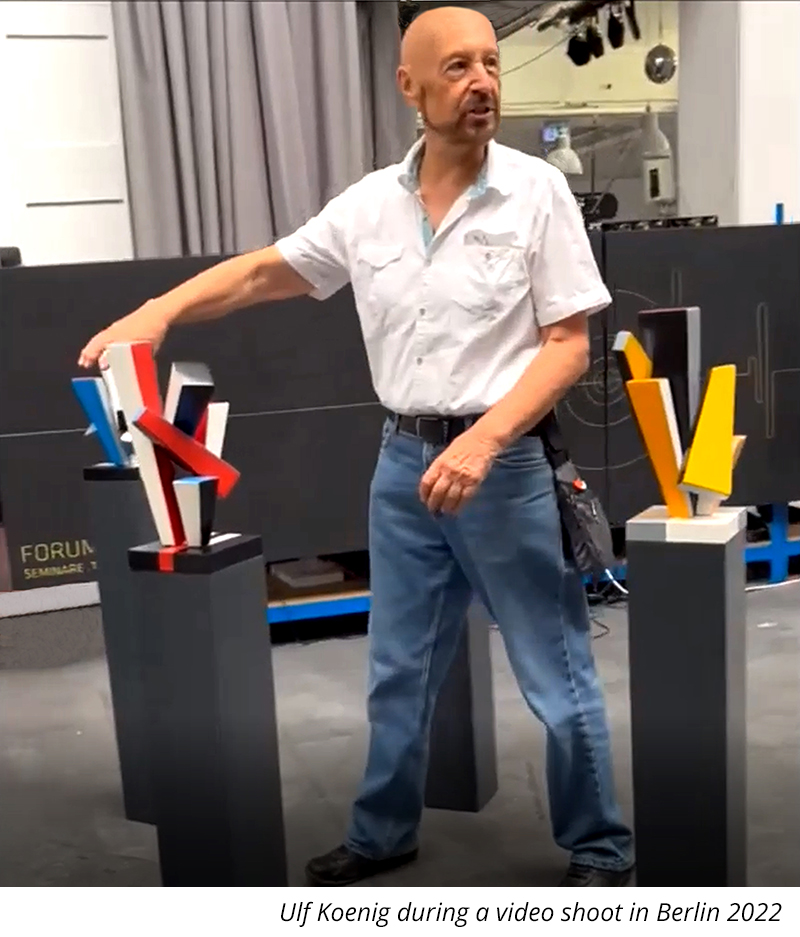
My mission:
Art meets Architecture, Architecture like Sculptures, Art beautifies Architecture, Artists inspire Architects, Artful Architecture enriches City-Life
The geometric forms of your works intersect, interpenetrate, seem to sprout from one another. What inspires you to create such expressive architectural images?
“Sprouting” is the natural process by which simple grains grow to complex plants. Indeed, that describes my working process very well, the stepwise development of my sculptures, by placing one module after the other. So the sculptures “grow” indeed higher and higher and becoming more complex. That’s conform with my general artistic goal, “Complexity from Simplicity”.
It looks as if I would be inspired by nature. No, that’s only true concerning the mounting process. My artworks never deal with topics of nature around us. I’m stronger influenced by technological, man-made objects, here the skyscrapers. As I don’t like their too functionalist designs, I try to modify them in an artistic manner.

From sculptures to installations. What do you intend with those?
Occasionally, my skyscrapers, mostly ten of them, have been composed as installations with the title “Vertical Constructivist Urbanism” and the subtitles “Avenue”, “City District” or “Buildings Row”. All sculptures therein are individually placed on a slim ”skyscraping“ pedestal, what both together merge to a thematic unit. The installation “City Square” has the man-high “Skyscraper Giant1” in the center, while four smaller sculptures are grouped around. This installation series shall provide visualizations of more artful cities.
In mid of 2022 the “Avenue” has been presented in Berlin’s Forum Factory. The audience has been fascinated by walking around to establish the artistic variety. During a video-shoot, I walked through and could report about my background and intention.
An exclusive quality of the skyscrapers should be emphasized, the chance to present them in various artistic arrangements. Not only as floor sculptures on pedestals, as I have mostly exhibited them, alternatively, however, even in “stalactite-like” compositions on apartment ceilings. Furthermore, I have tested their hanging on walls of galleries or living rooms, one or more close together, either framed or not. Such installations might associate crystals, literally growing out of the wall.
Was there a specific impulse that served as a basis for the creation of these series?
Decades ago, during business trips I saw a lot of metropolises, for instance, New York, Boston, Tokyo, Shanghai. I had been impressed by the huge skyscrapers on both sides of the streets. However, apart from a few contemporary exceptions, most of them have terrified me due to their boring functionality. They looked like upstanding, almost unstructured cuboids with facades, only interrupted by window holes.
I must confess, there is of course a need of vertical urbanism with residential and business towers close together, to fulfill environmental, economical, energetical and transport requirements. But the societal value lags far behind, due to their monotonous design and the absence of aesthetic. It’s obvious, that can’t touch the minds and hearts of people, in no respects.
It motivates me, to think about solutions for changing that. Why not listening to my own feelings settled between art, architecture and engineering to design unorthodox sky-scraper-like sculptures, built of simple geometric modules? I imagined a visionary city full of “my” skyscrapers, represented by the above mentioned city-like installations, but as high as the actual ones in metropolises. I was convinced to achieve beautiful and multiperspective architectural models for a future, humane city-life.
Does your artistic, architectural research relate in any way to your previous experience as an engineer and physical scientist?
Well, at first glance you wouldn’t attribute intuition, creativity and aesthetics to engineers or physicists! But the skills of these professions are not so far from those of artists, like perceptiveness, attention to details, experimentalism, iterative working and problem solving. The only difference is the “target objects”, in the case of engineers mostly hardware like the construction and testing of machines and for physicists materials and their developement and improvement. Especially engineers may not waive of beauty, at least a technical one, in order not to lose for buyers their system’s attractivity.
Based on my physics background, I realized in the beginning of my artist’s career minimalist organic sculptures, inspired by structures I have seen in microscopic, molecular scales, or sculptural star-perceptions based, however, on an astronomical scale. As time went by, engineering-wise more geometric forms have pushed through, and still dominate my artworks.
Your question addresses as a further topic, I.e. the architecture. Honestly, this discipline can’t be related to my educational and professional background. That dates back to my youth, where I had a strong fable for architecture. However, don’t ask me why I didn’t study architecture! At least remains my passion for that.
Will we ever be able to see something like this in reality in the urban landscape?
My concept follows in some ways the “interlacing principle” of the famous Ole Scheeren’s architecture. His buildings are also composed of crossing, intersecting, interpenetrating rectangular elements. My skyscraper models, instead, use angularly or asymmetrically arranged modules, exploiting my greater design-freedom as an artist.
A strong desire is, that once upon a time I might enter into a dialogue with architects to discuss the possibility of feeding into their skyscraper development the one or the other layout elements of mine. That dream would then perfectly satisfy the social mandate of art and create artful cityscapes, not only with “Art on Buildings” as practiced nowadays, but by a consistent implementation of a “Sculptural Architecture”.
By the way, I’m actively working on this dream and are in email contacts with various architecture offices. Most notably, they know my layouts now.
Can you describe your creative process?
It might sound surprising, that’s just for the artworks reported here,
I directly start with the realization, unlike applying the usual process flow of artists, starting with sketches. “I let it grow” from one 3D-module to the other, depending on my current mood and my spontaneous intuition.
In advance, however, I had prepared several lightweight modules of different dimensions, with styrofoam in the body covered with a thin layer of wood and colored with acrylic.
I start placing two or four on the ground plate, and insert as a test further modules, either upward or downward directed. When it meets my aesthetic perception I fix them. This stacking of modules ends up when the planned height is reached.
How would you describe your aesthetic or visual language?
My visual language aims to the pure abstraction of models for city architecture. It encompasses styles like futurism, constructivism and minimalism, as concerned with structure and color. From a far distance, the external shape of each sculpture shall look like an upstanding cuboid, structures which we know from actual city architecture. What features my sculptures is the inner structure, with various interlacing orientations of modules. Precisely these are rectangular, truncated pyramids of elongated dimensions. Partly the modules have got oblique end-faces. In the viewers mind that creates confusing, but inspiring impressions, ranging from strength, stability and regularity up to the opposite e.g. imbalance and diversity.
Stylistically viewed, I have merged constructivism with deconstructivism in a stunning way. The audience will recognize that as an amazing dynamism. While in the true teaching, constructivism turns away from displaying reality, in my more utopic post-constructivism I tolerate, I even prefer associations to real things. Related to my skyscrapers, I try to figure out a reshaping of city architecture for the benefit of the society.
Considering finally the language of colors and their significance for my models. Consistently, I use primary and so called noncolors. The last act as contrast and emphasize the spatial design. My blue-red skyscrapers evoke thoughts of techniques. The yellow one do “speak in softer tones”.
What happens, if one would omit the colors, e.g. in the case of an architectural implementation? Fortunately, we will still have the thrilling language of the modular construction.
Has there been a project you would say has failed? If so, why and what were your learnings from it?
Yes, unfortunately in respect to the series reported here. So far, all skyscrapers are in-house sculptures. However, I also want to make them suitable for outdoor placement, in order to bring colors together with the nature-contrasting constructivist style into gardens, parks or city-places.
For this purpose I tried to cover the sculptures with various weatherproofed clear varnishes. But due to the inside lightweight styrofoam terrible thinks happened with my test-models.
My first lesson from that: “be content with what you have”, i.e. already attractive in-house sculptures, my second one: “don’t give up and try it again”, and a third: “find experts to solve it”. Indeed, I discovered a fair-construction company, whose interest I could win.
What were your first memories around art? Was there a moment of epiphany when you thought you had found your calling?
I grew up in a culture-affine family, my mother a musician, my father a painter and cartoonist, who taught me in painting. I drew a lot, especially architecture visions, I read books about modern and fantastic architecture and I saw the icons of architecture in the world. During my professional period as a scientist and industry manager, I designed in my spare time flats for me and my friends and painted occasionally an artwork. But what should I do after my retirement, traveling, volunteering, reading or simply fulfilling household chores?
Once, sitting comfortably in in my armchair, my old sketch-book happened to be next to me. That was a pretty key moment, as thoughts of architectural structures flew on the paper. Even a few days later I realized the sketches by means of styrofoam and wood... and ever since I’ve been doing sculpturing.
What is most important to you about the visual experiences you create?
Thanks, this question allows me to summarize a bit my statements given before, and to make some critical remarks. Art and architecture are related disciplines, at least art-historically considered. Unfortunately, in practice there is not an intensive exchange of information, not to mention from a close cooperation. However, both groups are responsible for that. Architects are limited in their construction flexibility by building laws, site locations, topography, costs and more. Artists are living in a cloud-cuckoo-land, in a state of over-optimistic fantasy and are not truly caring about reality.
This gap I try to bridge by offering more artful models of buildings. I don’t want to revolutionize today’s construction features, like the pioneers of organic architecture commonly have to do. I apply standard geometric constructivist elements, simple ones which nevertheless allow nearly unlimited design flexibility. However, I must admit, that due to their uncommon interlaced arrangement a skyscraper-sized realization of my concepts would also require the one or the other technology development. But the effort seems to be worthwhile. Artists whom I have presented my models in physical and online exhibition, like yours, confirmed that by their positive response. However, whether architects do like the concept too, is still completely unclear.
What are your future endeavors? Do you have any new projects you can tell us about?
First of all, I’m presently constructing “Skyscraper Giant 2”, having the yellow-red, black, white, gray color scheme. Two medium-size skyscrapers shall follow. I plan to combine all skyscrapers to the new installation “Avenue-Extension” of the series “Vertical Construc-tivist Urbanism”. I hope, to find a gallery, where I can exhibit this many meters-long installation, and where the audience can safely walk around.
The most challenging project, however, concerns a “monotonous” art-management. Urgently, I have to revitalize my previous contacts to architecture offices and to establish new ones. I would be grateful for a polite, motivating feedback, even if an implementation may reasonably happen only sometime in the future.
